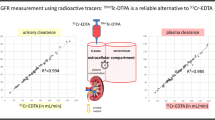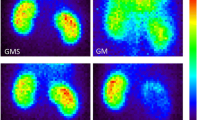Abstract
To evaluate effective renal plasma flow (ERPF) we performed renal scintigraphies with99mTc-Mercaptoacetyl-triglycine (MAG3) in ninepatients with glycogen storage disease I (GSD I) (age: 16±7 years). Two patients presented with proteinuria, none showed hyperaminoaciduria, disturbed tubular reabsorption of phosphate or hypertension.99mTc-MAG3 clearance values were elevated in eight out of nine patients (865±233 ml/min/1.73 m2 body surface area) and exceeded the agedependent mean values by 21%–145%. ERPF values in patients with poor metabolic control were higher than in patients with long-term good metabolic control (988±186 vs. 619±55 ml/min/1.73 m2;P<0.05). We conclude that enhanced ERPF is a common finding in GSD I patients, which preceeds clinically overt nephropathy. Renal scientigraphy with99mTc MAG3 is a suitable method for the early detection and monitoring of kidney dysfunction in GSD I.
Similar content being viewed by others
Abbreviations
- GSD I:
-
glycogen storage disease type I
- ERPF:
-
effective renal plasma flow
- GFR:
-
glomerular filtration rate
- 99mTc MAG3 :
-
99mtechnetium mercaptoacetyltriglycine
References
Baker L, Kern EFO, Olshan J, Goldfarb S, Dahlem ST (1988) Pilot study on captopril in patients with renal disease associated with glycogen storage disease type I (GSD I) (abstract). Pediatr Res 23:388
Baker L, Dahlem S, Goldfarb S, Kern EFO, Stanley CA, Egler J, Olshan JS, Heyman S (1989) Hyperfiltration and renal disease in glycogen storgae disease, type I. Kidney Int 35:1345–1350
Berg UB, Thalme B (1984) Early renal functional changes in children with insulin-dependent diabetes mellitus — their relation to metabolic control. Int J Pediatr Nephrol 5:15–21
Bubeck B, Piepenbeurg R, Grethe U, Ehrig B, Hahn K (1992) A new principle tonormalize plasma concentrations allowing single-sample clearance determinations in both children and adults. Eur J Nucl Med 19:511–516
Castellino P, Levin J, Shohat J, DeFronzo RA (1990) Effect of specific amino acid groups on renal hemodynamics in humans. Am J Physiol 258:F992-F997
Chen Y-T, Coleman RA, Scheinman JI, Kolbeck PC, Sidbury JB (1988) Renal disease in type I glycogen storage disease. N Engl J Med 318:7–11
Diamond JR, Karnovsky MJ (1988) Focal and segmental glomerulosclerosis: Analogies to atherosclerosis. Kidney Int 33:917–924
Mendez RE, Lopez R, Lopez G, Marti MS, Martinez-Maldonado M (1991) Effects of dopamine-receptor antagonists and renal denervationon amino acid-induced hyperfiltration. Am J Physiol 261:F70–75
Mogensen CE, Christensen CK (1984) Predicting diabetic nephropathy in insulin-dependent patients. N Engl J Med 311:89–93
Moorhead JF, Chan MK, Nahas MEI, Varghese Z (1982) Lipid nephrotoxicity in chronic progressive glomerular and tubulointerstitial diesease. Lancet: II:1309–1311
Oberhausen E (1981) Nuklearmedizinische Nierenclearance-Untersuchungen. Radiologe 21:548–552
Premen AJ, Powell DA, Carroll RG, Dobbins DE (1990) Renal vascular response to, amino acids: effect of pancreatectomy. Am J Physiol 258:F1154–1163
Reitsma-Bierens WCC, Smit GPA, Troelstra JA (1992) Renal function and kidney size in glycogen storage disease type I. Pediatr Nephrol 6:236–238
Ritz, E, Tönshoff B, Worgall S, Kovacs G, Mehls O (1991) Influence of growth hormone and insulin-like growth factor-I on kidney function kidney growth. Pediatr Nephrol 5:509–512
Trevisan R, Nosadini R, Fioretto P, Velussi M, Avogaro A, Duner E, Iori E, Doria A, Merkel C, Valerio A, Crepaldi G (1987) Metabolic control of kidney hemodynamics in normal and insulin-dependent diabetic subjects. Diabetes 36:1073–1081
Author information
Authors and Affiliations
Rights and permissions
About this article
Cite this article
Hahn-Ullrich, H., Sciuk, J., Bartenstein, P. et al. Effective renal plasma flow in patients with glycogen storage disease type I. Eur J Pediatr 152, 674–676 (1993). https://doi.org/10.1007/BF01955246
Received:
Accepted:
Issue Date:
DOI: https://doi.org/10.1007/BF01955246




